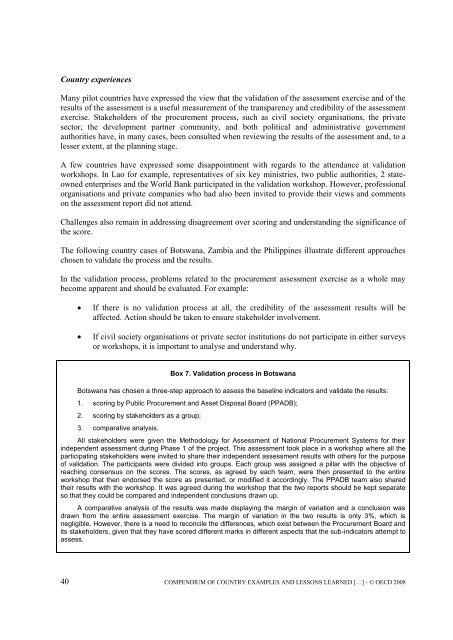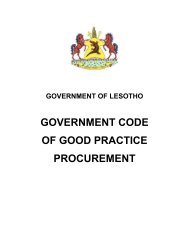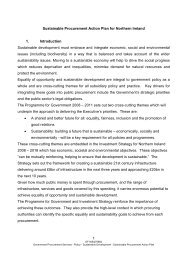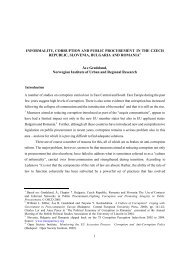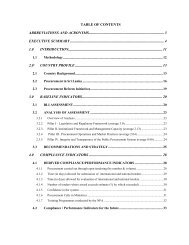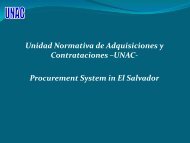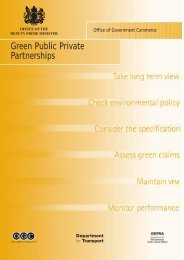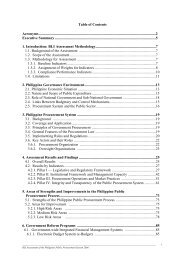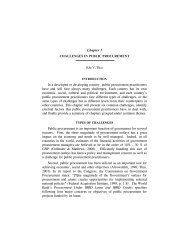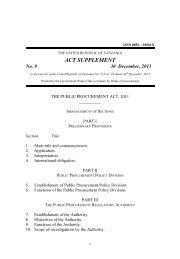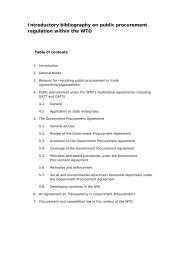Compendium of Country Examples and Lessons Learned from ...
Compendium of Country Examples and Lessons Learned from ...
Compendium of Country Examples and Lessons Learned from ...
Create successful ePaper yourself
Turn your PDF publications into a flip-book with our unique Google optimized e-Paper software.
<strong>Country</strong> experiencesMany pilot countries have expressed the view that the validation <strong>of</strong> the assessment exercise <strong>and</strong> <strong>of</strong> theresults <strong>of</strong> the assessment is a useful measurement <strong>of</strong> the transparency <strong>and</strong> credibility <strong>of</strong> the assessmentexercise. Stakeholders <strong>of</strong> the procurement process, such as civil society organisations, the privatesector, the development partner community, <strong>and</strong> both political <strong>and</strong> administrative governmentauthorities have, in many cases, been consulted when reviewing the results <strong>of</strong> the assessment <strong>and</strong>, to alesser extent, at the planning stage.A few countries have expressed some disappointment with regards to the attendance at validationworkshops. In Lao for example, representatives <strong>of</strong> six key ministries, two public authorities, 2 stateownedenterprises <strong>and</strong> the World Bank participated in the validation workshop. However, pr<strong>of</strong>essionalorganisations <strong>and</strong> private companies who had also been invited to provide their views <strong>and</strong> commentson the assessment report did not attend.Challenges also remain in addressing disagreement over scoring <strong>and</strong> underst<strong>and</strong>ing the significance <strong>of</strong>the score.The following country cases <strong>of</strong> Botswana, Zambia <strong>and</strong> the Philippines illustrate different approacheschosen to validate the process <strong>and</strong> the results.In the validation process, problems related to the procurement assessment exercise as a whole maybecome apparent <strong>and</strong> should be evaluated. For example:If there is no validation process at all, the credibility <strong>of</strong> the assessment results will beaffected. Action should be taken to ensure stakeholder involvement.If civil society organisations or private sector institutions do not participate in either surveysor workshops, it is important to analyse <strong>and</strong> underst<strong>and</strong> why.Box 7. Validation process in BotswanaBotswana has chosen a three-step approach to assess the baseline indicators <strong>and</strong> validate the results:1. scoring by Public Procurement <strong>and</strong> Asset Disposal Board (PPADB);2. scoring by stakeholders as a group;3. comparative analysis.All stakeholders were given the Methodology for Assessment <strong>of</strong> National Procurement Systems for theirindependent assessment during Phase 1 <strong>of</strong> the project. This assessment took place in a workshop where all theparticipating stakeholders were invited to share their independent assessment results with others for the purpose<strong>of</strong> validation. The participants were divided into groups. Each group was assigned a pillar with the objective <strong>of</strong>reaching consensus on the scores. The scores, as agreed by each team, were then presented to the entireworkshop that then endorsed the score as presented, or modified it accordingly. The PPADB team also sharedtheir results with the workshop. It was agreed during the workshop that the two reports should be kept separateso that they could be compared <strong>and</strong> independent conclusions drawn up.A comparative analysis <strong>of</strong> the results was made displaying the margin <strong>of</strong> variation <strong>and</strong> a conclusion wasdrawn <strong>from</strong> the entire assessment exercise. The margin <strong>of</strong> variation in the two results is only 3%, which isnegligible. However, there is a need to reconcile the differences, which exist between the Procurement Board <strong>and</strong>its stakeholders, given that they have scored different marks in different aspects that the sub-indicators attempt toassess.40 COMPENDIUM OF COUNTRY EXAMPLES AND LESSONS LEARNED […] - OECD 2008


